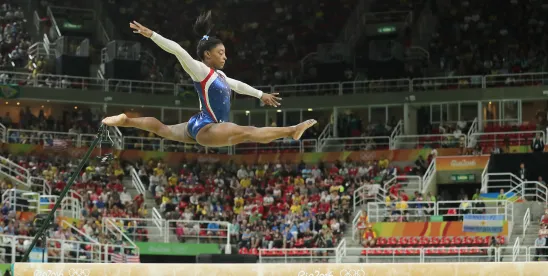For the first time in history, Team USA’s gymnasts gathered on NBC’s “TODAY” Show to publicly unbox their team uniforms prior to competing in the 2024 Paris Olympics. Simone Biles, Suni Lee, Jordan Chiles, Jade Carey, and Hezly Rivera opened their personalized red boxes to reveal a star-spangled red, white, and blue leotard, bedazzled in up to 10,000 Swarovski crystals. The new 2024 Paris Olympics uniforms incorporate the vintage feel of the iconic 1984 Team USA leotards, but with a modern twist of added bling and advanced technology.
Produced in partnership with GK Elite Sportswear, the world’s leading gymnastics apparel brand for over 45 years, the form-fitted, long-sleeve leotards were created with an innovative satin material. The satin was required to pass a four-way stretch test, making the fabric suitable for a gymnastics performance filled with constant movement. Lead designer, Jeanne Diaz, was sure to consider both looks and practicality when designing the team leotards, saying, “I want them to feel so confident in what they’re wearing, not only the aesthetics of what they’re wearing, but also the function of what they’re wearing, that they can really focus on their performance.” . The fabric’s properties help ensure that the high-cut leg line stays in place to prevent the gymnasts from receiving deductions for readjusting their uniforms while competing.
With such a high number of crystals, a computer-aided design program is needed to determine exact crystal placement. One technique used for crystal application involves a precision laser with a presser foot, which applies crystals individually with greater precision. However, due to the high-profile nature of the Olympics, GK Elite applied larger crystals by hand using tweezers.
Each year, the technology and fashion design present in Team USA’s leotards has become increasingly innovative and modern. Reflecting on the classic Olympic gymnast leotards of the past reveals a fascinating evolution, from historic simple designs to today’s stylish, embellished suits.
Prior to the invention of spandex, leotards made in earlier decades were created with a combination of cotton, nylon, and other semi-stretchy fabrics. Women gymnasts competing in the 1948 London Olympics wore white high-neck leotards featuring simple stripes running diagonally across the front with an American flag emblem on the upper left, as the technology for a more thrilling pattern had not yet developed. Unlike contemporary gymnastics attire that utilizes form-fitting materials, these uniforms may appear visually ill-fitting in contrast.
During the 1968 Mexico City Olympics, Cathy Rigby wore a simple uniform that incorporated a ruched (a pleated, fluted, or gathered strip of fabric used for trimming) detailing on the chest and an American flag emblem in the center. Spandex, a material that was just starting to appear in Olympian attire in 1968, had not yet become widely used in gymnastic leotards. As such, Rigby’s leotard, made from polyester, while having a slightly tighter fit than leotards of previous decades, still featured bunchy fabric around the arms, as the material incorporated fewer elastic qualities. In later decades, the leotard evolved to accommodate the advancement of gymnastics, allowing athletes to comfortably pursue a greater range of motion and more complex choreography.
In the 1980s, gymnastics uniforms underwent a complete transformation. Leotard manufacturers began using spandex and Lycra[MJA1] ®, a highly elastic synthetic fabric, allowing for uniforms to become more form-fitting. Designers began opting for tighter fits for both aesthetics and scoring purposes. As asserted by Olympique, a gymnastics apparel designer and manufacturer, the tightness “allows both judges and coaches to clearly see the gymnast’s alignment and every single move properly without excess material”. Designers also introduced higher-cut leg openings, a choice which had not only fashionable, but technical effects, creating the illusion of elongated legs and thus longer movement lines for gymnasts who, often, have shorter statures.
This also marked the first era of designers incorporating elaborate, patriotic patterns on the Team USA leotards, which made the 1984 uniform especially iconic. The star-spangled design, along with the team’s medal victories at the Games, made the 1984 U.S. Olympic gymnastics team’s attire a symbol of athletic excellence. Due to the leotard’s popularity, Mary Lou Retton chose to wear the distinctive uniform during her appearance on The Tonight Show with Johnny Carson.
The 1996 U.S. women’s Olympic team, known as the Magnificent Seven, wore patriotic, standard spandex leotards inspired by the 1984 Team USA uniforms. Head coach Marta Karolyi requested white leotards to outline the athletes’ muscular physiques. “Marta insisted on white bodies. She wanted to show off the abs of the athletes,” said Kelly McKeown, executive vice president of design and corporate relations at GK Elite.
Leotards in the new millennium underwent yet another drastic transformation. GK Elite utilized sublimation to manufacture the 2004 Team USA Olympic leotards, specifically to imprint the blue stars and red stripes onto the white base. Sublimation technology involves printing designs onto sheets of paper and heat-transferring the design onto the fabric. A machine, heated to 450° Fahrenheit, turns the ink printed on the paper into gas and fuses it into the fabric to create a custom design.
Additionally, the shiny red and blue stripes of the 2004 Team USA uniforms were made of “Mystique,” a new fabric composed of a nylon spandex base layered with small foil dots that cover nearly the entire surface, giving the fabric a fashionable metallic sheen. The elastic Mystique fabric is still widely used in modern-day leotard manufacturing and is popular due to its elasticity, fashionable attractiveness, and capability of showcasing the gymnast’s physique. Other advancements in leotard technology included the use of elastane and latex, as was the subject of a 2011 patent application for a leotard featuring a geometry adapted to make a neck portion of the leotard invisible and capacity for elastic deformation (the temporary change in the form of an object due to applied stress, which reverts to its original shape once the stress is removed) (FR Patent No. 2978648).
With inspiration shifting away from traditional patriotic patterns, team USA’s bright pink bedazzled uniforms showcased at the 2012 London Olympics were heavily influenced by figure skating costumes. These bold leotards were almost entirely made of the patented Mystique fabric.As described by uniform manufacturing partner GK Elite, “the fabric color shows through behind the shimmering foil for the look of gilded brilliance.” The Mystique fabric was more prevalent than ever in the 2010s, as it was a thinner, more lightweight material that allowed gymnasts to feel more comfortable during elaborate performances under the warmth of the arena lights.
At the 2016 Rio de Janeiro Olympics, the Final Five dazzled in Mystique bodysuits embellished with nearly 5,000 Swarovski crystals. These uniforms marked a full-circle return to the patriotic colors that were largely prominent in the 80s and 90s. Still made from Mystique, the four-way stretch technology of the fabric continued to be improved for further support. As affirmed by McKeown, “the fabrics just keep getting more and more techy with the stretch and recovery.”
The crystals were designed to be lightweight, and Swarovski continues to develop even lighter variants of crystals for future designs, in addition to pursuing other cutting-edge innovations in crystal technology in areas such as cut and color. Swarovski has a pending patent application, filed in 2022, on a method of cutting a gemstone (European Patent Application No. EP4371443A1), and another, filed in 2021, on a method of applying a colored coating to a crystal in which ink is mixed with a polymerizable organic carrier and applied via a plasma, allowing the ink mixture to polymerize on the surface of the crystal (U.S. Patent Application Publication No. 20230272234A1).
As gymnastics has evolved, uniforms have evolved to accommodate both fashion and function. To accomplish this, innovative materials developed throughout the decades have been used. In many ways, as the advancements in gymnastics uniforms made them more flexible and form-fitting, the ability to perform more athletic maneuvers has resulted — could Simone Biles perform her infamous triple-double floor routine move wearing the uniform of the 1940s? Fabric technologies have likely enabled gymnasts at every level of gymnastics to perform routines that are nothing short of amazing. With each summer Olympics, the uniforms seem to increasingly feature more and more technological advancement — and crystals too — ensuring they shine just as bright as the gold medals that Team USA will continue to earn.
A special thanks to Crystal ElAchkar, a summer patent agent in our Chicago office, for her contributions to this article.
[MJA1]I believe Lycra carries the Registered logo as part of the name
Find the previous articles in this series here: Article 1, Article 3, Article 4, Article 5





 />i
/>i
